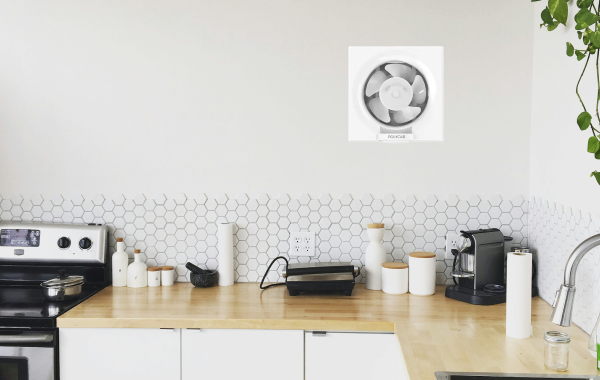7 Essential Exhaust Fans Maintenance Tips

- April 07, 2025
- No comments yet
7 Essential Exhaust Fan Maintenance Tips
Exhaust fans play a crucial role in maintaining proper ventilation and indoor air quality. Whether it is installed in the kitchen, bathroom, or a commercial space, they help keep smoke and foul odours away, thus removing humidity and keeping the air clean for breathing. Yet, exhaust fan maintenance is often neglected until performance issues arise. It is essential to maintain exhaust fan upkeep activities for smooth operation and increased longevity. This detailed guide will dive deeper into the 7 essential exhaust fan maintenance activities that help circulate fresh air and help preserve the health of your indoor environment, thus enhancing your living experience.
Why is Proper Exhaust Fan Maintenance Essential?
Over time, exhaust fans accumulate dust and grease and require regular cleaning to perform at their best. The oil and smoke fumes released in the kitchen can get clogged in the exhaust fan blades, reducing air ventilation and increasing energy consumption.
Bathroom exhaust fans keep the moisture and excess humidity under control. However, with prolonged use, moulds can accumulate over them, decreasing the air quality. Regular exhaust fan maintenance helps to
- Maintains proper air ventilation and circulation across the room.
- Increases the life of motors and other components.
- Reduces potential fire hazards
- Elevates indoor air quality and hygiene
Regular Cleaning of Exhaust Fans
Conducting regular exhaust fan cleaning activities is essential for proper maintenance. The dust and grease accumulated on the exhaust fan blades and grills can negatively affect the airflow and cause a strain on the motor. Follow the procedure below for regular exhaust fan cleaning. It is a DIY process that can be executed every 4-6 weeks.
- Ensure that you switch off the power supply before cleaning the fan.
- If required, disassemble the grill or cover using appropriate tools.
- Use a handheld vacuum cleaner to remove loose dust effectively.
- Use a damp cloth dipped slightly in a mild detergent solution and wipe off the exhaust fan blades.
- Wash the reusable filters with warm, soapy water and a little vinegar, especially if they have a lot of grease accumulated on them.
- Once all the components are dried after cleaning, reassemble them and switch on the power supply. The cleaned exhaust fan should function smoothly with no noise
Checking and Replacing the Fan Blades
Damaged fan blades can make more noise, reduce the efficiency of the exhaust fan, and speed up the wear and tear of the motor. Periodically inspecting exhaust fan blades is crucial for maintaining proper ventilation in the kitchen or bathroom space. The following signs indicate that the exhaust fan blades need to be checked or replaced.
- Bending, warping, or deformation of blades
- Consistent corrosion or grime
- Visible noise or imbalance while rotating
- Becoming too noisy while functioning
If the problem still persists despite regular cleaning of the exhaust fan blades, it is time to replace the current exhaust fan blades. Look for branded exhaust fans that are known for their reliability and longevity.
Lubricating the Fan Motor for Smooth Operation
With time, the internal bearings of an exhaust fan motor may dry out, creating a squeaking noise or uneven rotation. However, exhaust fan lubrication ensures smooth operation and optimal performance.
To lubricate the fan motor, identify the areas on the motor shaft that require lubrication. Add a few drops of machine oil into each port and manually rotate the fan blades to evenly distribute the oil across the moving parts. Before lubricating the fan motor, ensure that the power connection is switched off.
Inspecting Ducts and Vents for Blockages
Blocked exhaust fan ducts can reduce indoor air quality and decrease the efficiency of exhaust fans. If there is visible mold growth or unpleasant odors, it's time to inspect the ducts and vents.
Look for accumulated dust and grease. Ensure all the sections are securely connected and undamaged. Perform duct inspections twice or three times a year to maintain unobstructed airflow and reduce strain on the motor.
Ensuring Proper Ventilation and Airflow
After the regular exhaust fan upkeep activities, it is essential to check that the exhaust fan circulates air properly and that the airflow is maintained. To test the airflow, switch on the exhaust fan and hold a piece of paper near the vent. If it is drawn inward quickly, it indicates that the airflow is proper, and the ventilation is maintained.
However, if the exhaust fan underperforms, consider upgrading to a higher-capacity unit that best aligns with your space requirements.
Scheduling Professional Exhaust Fan Inspections
While DIY efforts are valuable, a professional exhaust fan inspection offers an in-depth assessment of the fan's health. Whether you have an exhaust fan installed in a commercial setting or a residential space, having experts can help detect emerging issues before they escalate. Scheduling a professional exhaust fan inspection twice annually will help.
- Get an in-depth inspection of the motor and bearings.
- Identify potential mechanical problems early on, thus maintaining longevity.
- Conduct a comprehensive duct cleaning and blockage removal process.
- Regulate airflow across the bathroom or kitchen.
Common Problems and How to Troubleshoot Exhaust Fans
Despite regular exhaust fan maintenance, minor problems can sometimes occur that, left unattended, can lead to major breakdowns of your exhaust fan. A few common exhaust fan problems are explained below, along with their troubleshooting tips.
-
Fan Blades Not Spinning Properly: An uneven electrical supply, tripped breaker circuit, or a faulty switch could be the prime cause of the exhaust fan blades not working smoothly.
Troubleshooting tip: Check the power source, breaker panel, and wall switches to ensure they are all functioning correctly. If everything looks good, check the exhaust fan motor and its other components for dust and debris. Replace the motor if it is found faulty.
-
Too Much Noise: Accumulation of dirt and dust, misaligned or damaged blades, worn-out motor bearings, or improper installation could be the reason that the exhaust fans radiate a lot of noise while operating.
Troubleshooting tip: Thoroughly conduct exhaust fan cleaning to remove clogged dust, apply fan lubrication properly, ensure it is securely mounted, and replace the damaged parts.
-
Improper Air Ventilation: Clogged duct trapped moisture or mold, and improper size of the exhaust fan could primarily lead to improper air ventilation across the room.
Troubleshooting tip: Clean the ductwork or the exterior vent of the exhaust fan. If necessary, consider upgrading to a higher CFM version model.
Quick identification of such problems can help troubleshoot well in advance and significantly extend the functional lifespan of exhaust fans.
Maintain Your Exhaust Fans for Long-Lasting Performance
Exhaust fans play an instrumental role in safeguarding indoor air quality and ensuring a healthy living space in your home. However, having a proper exhaust fan maintenance routine is essential for its consistently high performance and long durability. Here are a few tips to maintain your exhaust fan for optimal performance.
- Regularly monitor the exhaust fan blades for their alignment within the fencing system. Replace or call for professional assistance at the first signs of misalignment.
- Regularly assess the power supply and repair any wiring faults.
- Inspect and clean ductwork and external vents regularly.
- Inspect the airflow and conduct air ventilation maintenance activities to ensure effective circulation of fresh air.
- Conduct regular cleaning of all exhaust fan components.
- Lubricate the exhaust fan motor every 2 to 3 months to maintain smooth operation.
- Schedule annual exhaust fan inspection by professional experts.
At Polycab, we believe in the importance of exhaust fans and their crucial role in maintaining a fresh and healthy indoor atmosphere in both heavenly homes and bustling commercial spaces. Our Polycab Super ROI range of exhaust fans includes kitchen, bathroom, and industrial exhaust fans. They are engineered for more extended durability, high performance, and minimal maintenance. Preserve your indoor air quality and experience what it means to breathe fresh air every moment in your home.
RECENT POSTS
- Where & How to Install LED Strip Lights for That Sleek, Modern Glow
- How to Use LED Strip Lights on Ceilings for a Modern Aesthetic
- 7 Bright Lighting Ideas to Refresh Your Living Space with Polycab LEDs
- 5 Things to Look for Before Selecting an Exhaust Fan for Your Home
- 5 Key Factors to Consider Before Buying Modular Switches and Sockets
 Fans
Fans
 Wires
Wires
 Lighting
Lighting
 Switches and Accessories
Switches and Accessories
 Water Heaters
Water Heaters
 Switchgear
Switchgear
 Polycab Home Advisors
Polycab Home Advisors
 Cables by Application
Cables by Application Cables by Standards
Cables by Standards Cables by Type
Cables by Type Renewables
Renewables Corporate
Corporate News and Media
News and Media Life at Polycab
Life at Polycab Contact Us
Contact Us Financial & Corporate Information
Financial & Corporate Information Annual Reports
Annual Reports Shareholder’s Information
Shareholder’s Information Credit Ratings
Credit Ratings Latest Updates
Latest Updates Notices
Notices Corporate Governance
Corporate Governance Corporate Action History
Corporate Action History Investors Contacts
Investors Contacts Disclosures under Regulation 46
Disclosures under Regulation 46


